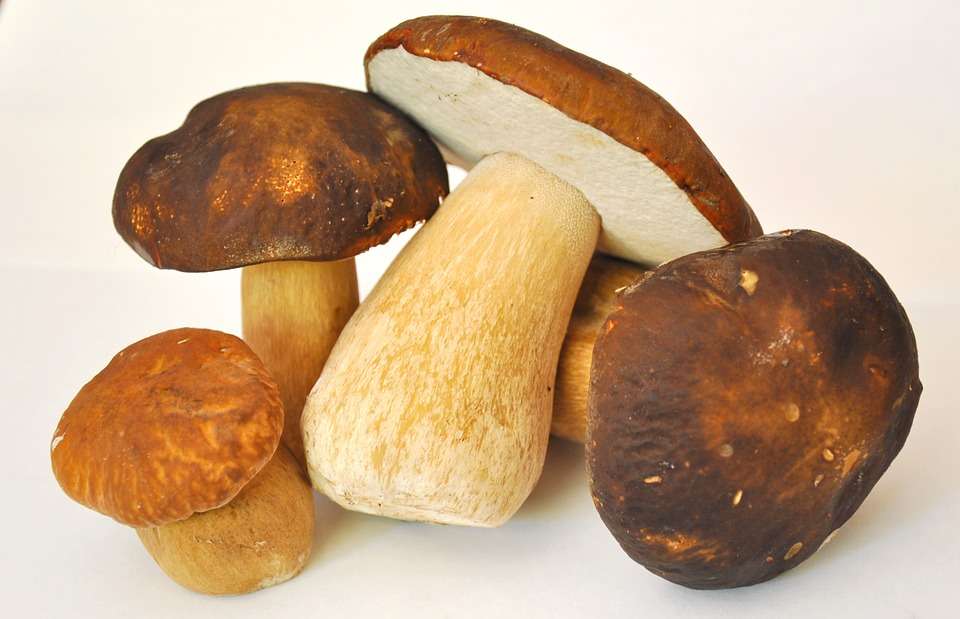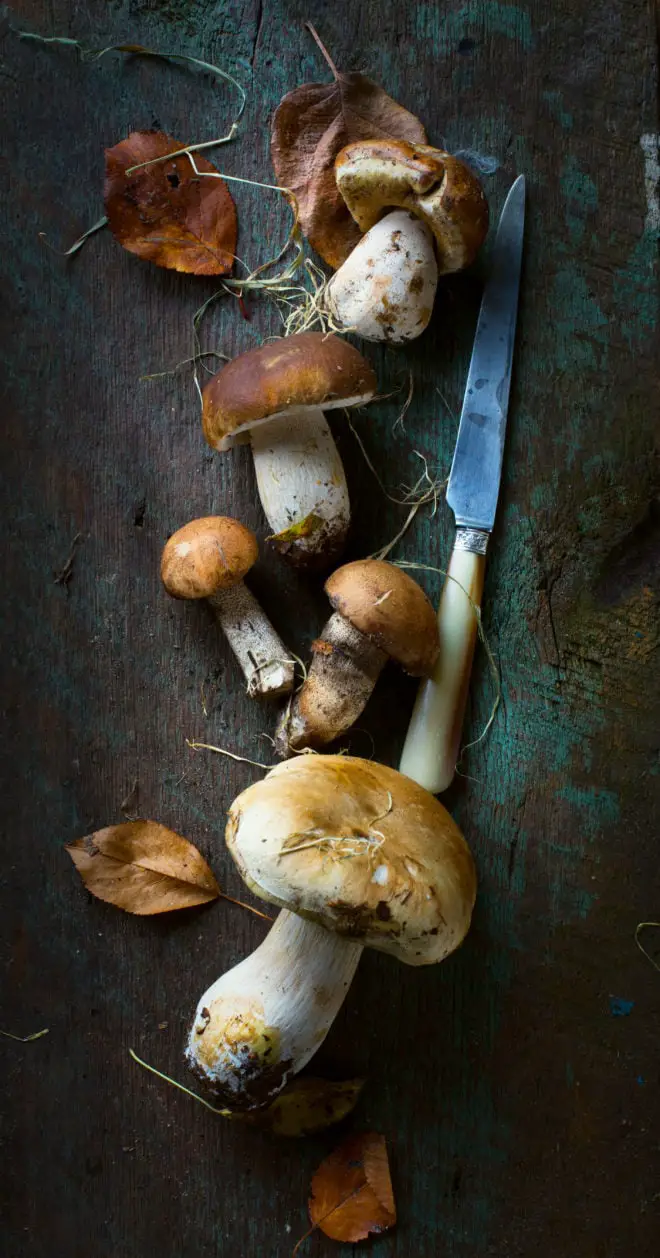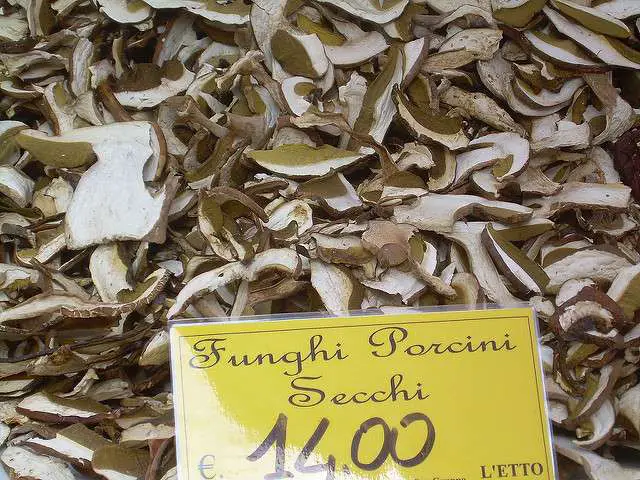Table of Contents
Porcini Mushroom
Fungo porcino (plural: porcini) or Boletus edulis is an edible mushroom from the fungi family. It is commonly used as an ingredient in soups, pasta, risotto, and many other dishes. It grows in the woods on trees, thus it gives an essence of the woodlands with its earthy flavor. Not only it is a flavorful food item, but it is also a good substitute for meat if you are vegetarian.
Fresh porcini mushrooms are available during autumn in Northern, Central, and Southern Europe. However, this type of fungi is mycorrhizal. It only grows on a host tree. This makes it impossible to be cultivated for commercial purposes and can only be sourced by foraging. That is why porcini mushrooms are rare and expensive. It is mostly available in its dried form, packaged and distributed worldwide.
Porcini mushroom is considered one of the safest wild mushrooms as no poisonous specie closely resembles it.
Different Names, Same Mushroom
Although the scientific name of porcini mushroom is Boletus edulis, it is known in different names across Europe. It Italy, it is called fungo porcino (plural: porcini or pig mushroom). In Germany, it is called steinpilz (stone mushroom). In France, it is known as cèpe. In Russia, it is known as bely grib (white mushroom). In Albania, it is called wolf mushroom. In England, it is called penny bun or King Bolete.
What Does It Look Like?
When mature, the cap measures 2.8 to 11.8 inches wide and slightly sticky to touch. When young, it is convex and flattens out as it age. It is reddish-brown that fades to white in areas near the edges and continues to darken as it matures. The stem is 3.1 to 9.8 inches high and 2.8 inches thick. It is club-shaped and bulges out in the middle. The top of the stem is finely reticulate and goes smooth or irregularly ridged on the lower part. The undersurface of the cap is made of thin tubes which are 0.4 to 0.8 inches deep. It is white when young but turns to greenish-yellow as it matures.
They are easy to identify and it is not likely that you’ll pick a poisonous look-alike. B. edulis is one of the safest wild mushrooms. Supposedly, all boletes are edible except for the Satan’s bolete type which is bright red under its cap.

Where to Find Them
As mentioned earlier, porcini mushrooms are mycorrhizal. That means it only grows in symbiosis with a host tree-like beech and birch trees. It can only forage and it can’t be cultivated for commercial purposes. Fresh porcini mushrooms are much available in Europe than in the United States. If you don’t have the time to go mushroom hunting and picking, you can find them in the farmers market or local grocery stores. Because of this reason, porcini are hard to find, thus expensive. Around the world, it is common to find packed dried porcini mushrooms than fresh.
Selecting Fresh Porcini
Gourmets prefer the young, small porcini over the large ones. For one, large ones are soft, slimy, and less tasty with age. For another, large porcini often harbor insects.
When picking, hold the stem near the base and twist it gently. Cutting the stem with a knife may risk destroying the mycelium and may not grow again. Look for firm and undamaged mushrooms. Avoid those with small holes which may indicate the presence of maggots or worms. Check under the cap for black spots or dark green color which indicates that the mushroom is already overripe. Cut the mushrooms in half to check for maggots and worms immediately after harvesting.
Avoid picking porcini mushrooms near industrial sites, highways, or railroads. Heavy metals and toxins like mercury and cadmium can accumulate in the mushrooms and may cause health problems and toxicity when consumed.

- autumn cooking background; seasoning forest organic porcini Mushroom;
Using Fresh Porcini
Peeling and washing porcini mushrooms directly in hot water are not recommended. Wipe away any dirt using a damp cloth or towel to clean them. You may only wash them with water if you will be using the mushrooms right away.
Porcini can also be frozen raw or pre-cooked in butter. If frozen for more than four months, the color, aroma, and taste of frozen porcini may deteriorate. If you need to freeze the mushrooms longer, it is better to blanch them before freezing. It can extend the mushrooms’ freezer life up to one year.
Porcini should be thoroughly cooked before eating. Avoid eating raw porcini mushrooms because it can irritate the stomach or may cause allergic reactions. If you experience any adverse reactions or side effects after eating porcini mushrooms, immediately stop eating and consult your doctor.
Drying Porcini Mushroom
Because of its rarity and expensiveness, most people use dried porcini mushrooms. It has its intense flavor and texture and can be easily rehydrated.
Drying Using a Food Dehydrator
My grandmother’s process is simple. After washing the mushrooms, slice them thin. Place them in the dryer, making sure that they don’t overlap on the trays. Dry it at 140°F for 8 hours.
If you don’t yet have a food dehydrator, take a look at our recommendations: here
Air Drying
Tie the porcini mushrooms separately with a string and hung close to the ceiling of the kitchen. Or you can brush clean the mushrooms then place them in a wicker basket or bamboo steamer on top of a boiler or hot water tank.
Drying Using an Oven
Dry porcini mushrooms in a pre-heated oven at 77°F to 86°F for two to three hours. Then increase the temperature to 122°F until crisp or brittle.
Once dry, keep the porcini mushrooms in an airtight jar.
Using Dried Porcini
When selecting or buying dried porcini mushrooms, choose the whole dried with a strong smell. Avoid packages with too much-crumbled pieces as the flavors may not be as strong.
Steep dried porcini in boiling water enough to cover them for 15 to 20 minutes. If the recipe calls for water or other liquids, you may use drained mushroom water to add flavor.
After draining, chop them and add to your recipe like any fresh mushroom.
Uses of Dried Porcini Mushrooms
The popular ways to use porcini are grilled or stewed with thyme or nipitella herbs. Here are other ways you can use your dried porcini mushrooms:
- sauces
- soups or stews
- serve fried as an appetizer
- topping for chicken, steak, or fish
- pasta recipe especially risotto
- grill the mushroom cap-like meat steak
- canned in olive oil, then grilled or fried; it enhances the flavor of the olive oil
- paste to become spreads on bread
- pizza topping
Nutritional Value
B. edulis contains vitamin A, vitamin C, calcium, protein, iron, antioxidants, and dietary fiber. It has a meaty and savory taste that can be included in any vegetarian meal. These mushrooms also help improve digestion, promote weight loss, reduce inflammation and may prevent colon cancer.
An ounce of dried porcini mushrooms contains 5 mg iron which is 20% of the daily value, 14 g carbohydrates, 7 g protein, 7 g dietary fiber, and 105 calories.
Final Thoughts
One chef called the porcini mushroom as the “wild mushroom par excellence” because of its taste and versatility. It is considered a choice edible in Europe particularly in Italy, France, Germany, and Poland. However, because of its mycorrhizal nature, it is difficult for producers to cultivate it for commercial mass production. Thus, this food item is expensive and rare in other parts of the world.
If you have the opportunity to pick fresh porcini mushrooms, drying them for future use is easy.

